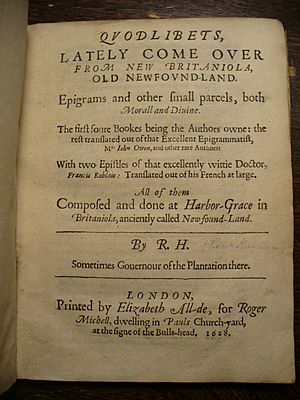Robert Hayman facts for kids
Robert Hayman (born August 14, 1575 – died November 1629) was a poet and an early leader in the Newfoundland colony. He was the first and only Proprietary Governor of a settlement called Bristol's Hope. This was a time when England was starting to build new communities in North America.
Contents
Robert Hayman's Early Life and Education
Robert Hayman was born in a place called Wolborough, near Newton Abbot in England. He was the oldest of nine children. His father, Nicholas Hayman, was a successful person who became the mayor and a Member of Parliament (MP) for two towns, Totnes and Dartmouth. An MP is a person chosen to represent a group of people in a country's parliament.
When Robert was a small boy, his family lived in Totnes. He once met the famous explorer Sir Francis Drake on the high street, and Drake gave him an orange! Robert even wrote about this moment in one of his poems later on.
Robert went to Exeter College at Oxford University when he was 15 years old. He later studied law at Lincoln's Inn, which is a place where people learn to become lawyers. After his studies in England, he traveled to Europe to study more, even going to the University of Poitiers in France.
Robert was known for his love of poetry. He became friends with many famous writers of his time, like Ben Jonson, Michael Drayton, and John Donne. These friends encouraged him to write, and he became known as a poet. Even though he was well-known for his writing, he didn't hold any big government jobs in England. After a quiet period, he became interested in exploring and settling new lands.
Robert Hayman's Family Life
In 1604, Robert Hayman married Grace Spicer in Exeter. Grace was the daughter of an important merchant. It seems they did not have any children, and she may have passed away when she was young. However, Robert remained friendly with her family, dedicating some of his poems to them.
Robert Hayman's Time in the Colonies
In 1618, Robert Hayman was chosen to be the first governor of the Newfoundland colony. This happened after a group of merchants from Bristol, England, received a special permission from King James I of England to start a settlement. Robert's brother-in-law was in charge of this merchant group.
Robert lived in the colony for 15 months. He also visited Newfoundland several times during the summers until his time as governor ended in 1628. A lot of his work involved raising money for the settlement and encouraging more people to move there. He even suggested building a new town called 'Carolinople' (which means "Charles's Town") to King Charles I.
Robert Hayman is remembered as the first English poet in Newfoundland. He wrote many poems praising the island, its weather, and the early English settlers. While he was governor in Harbour Grace, he wrote a book called Quodlibets. This book was published in London in 1628 and was the first book in English written in what is now Canada. Quodlibets included his own short poems and translations of poems by others. He likely published it to get more people interested in the colony.
Even though Robert was dedicated to Newfoundland, he was also interested in other colonial projects, like one in Guyana in South America. He made his will in late 1628 and then set sail for the Amazon region. By early 1629, he was in Guiana, exploring the 'Wiapoco' river (now called Oyapock) as a possible trading route.
Robert Hayman's Death
While traveling up the Oyapock river by canoe, Robert Hayman suddenly became ill with a fever. He died around October 17, 1629, and was quickly buried by his companions near the riverbanks. His will, which was officially approved in 1633, left his belongings to his cousin and nephew, Thomas Muchell. His will also mentioned two insurance policies, one for his ship's safe arrival in Guiana and another for his own life.
See also


